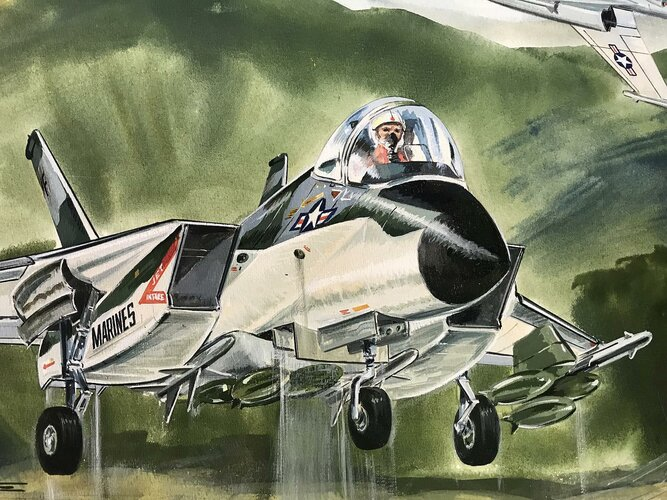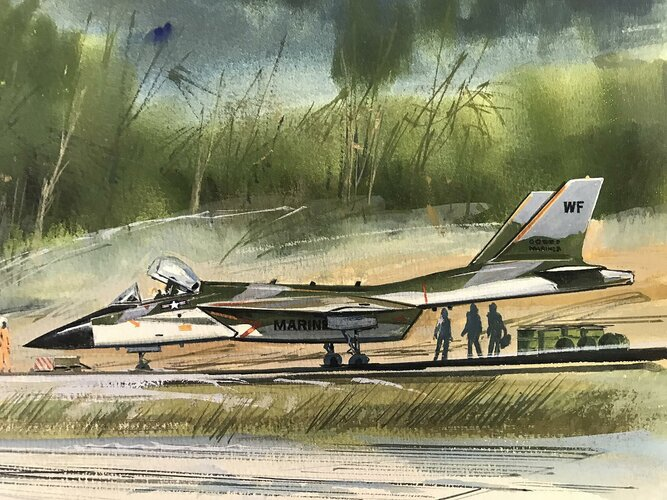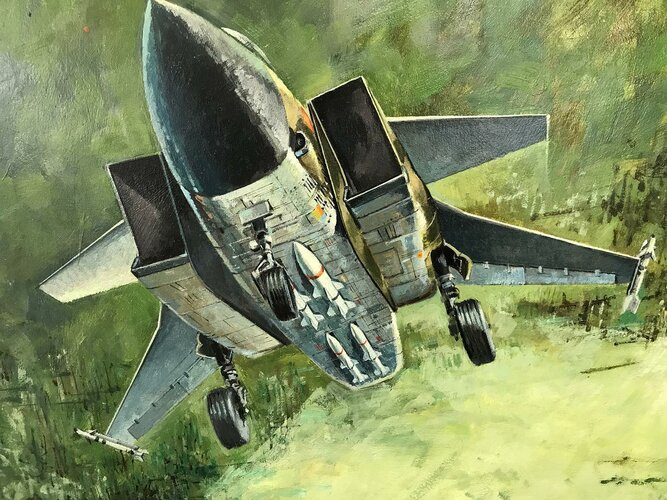Grumman Model 623 VSTOL/CTOL Navy Fighter (VFAX)
- Thread starter hesham
- Start date
- Joined
- 26 May 2006
- Messages
- 34,916
- Reaction score
- 15,790
hesham said:Hi,
it was Grumman Model-623.
A very strange,the Grumman G-623 mention here,but with canard !.
http://ntrs.nasa.gov/archive/nasa/casi.ntrs.nasa.gov/19890000646_1989000646.pdf
Attachments
- Joined
- 27 December 2005
- Messages
- 17,752
- Reaction score
- 26,445
- Joined
- 27 December 2005
- Messages
- 17,752
- Reaction score
- 26,445
From a 1979 NASA Contractor report - CR-166365
Different variant with highly swept wings. According to Tony Buttler G-623V V/STOL version was distinguished by highly swept wings, so I suspect this is G-623V.
Different variant with highly swept wings. According to Tony Buttler G-623V V/STOL version was distinguished by highly swept wings, so I suspect this is G-623V.
Attachments
- Joined
- 27 December 2005
- Messages
- 17,752
- Reaction score
- 26,445
STUDY OF AERODYNAMIC TECHNOLOGY FOR VSTOL FIGHTER/ATTACK AIRCRAFT - PHASE I FINAL REPORT
Walter R. Burhans, Jr, Vincent J. Crafa, Jr, Nicholas F. Dannenhoffer, Frank A. Dellarnura, Robert E. Krepski, GRUMMAN AEROSPACE CORPORATION
http://ntrs.nasa.gov/archive/nasa/casi.ntrs.nasa.gov/19790001856_1979001856.pdf
Walter R. Burhans, Jr, Vincent J. Crafa, Jr, Nicholas F. Dannenhoffer, Frank A. Dellarnura, Robert E. Krepski, GRUMMAN AEROSPACE CORPORATION
http://ntrs.nasa.gov/archive/nasa/casi.ntrs.nasa.gov/19790001856_1979001856.pdf
In 1973, Grumman and General Electric participated in a Navy exhaust nozzle development program. The resulting Grumman Design 623 using the General Electric ADEN nozzle has since been extensively tested in wind tunnels both here and abroad. This testing has ranged from VTOL hot gas tests to transonic and supersonic powered and flow-through model tests. This background data provided a starting point for this study.
Since its initial conception five years ago, advances in the state-of-the-art in propulsion, aerodynamics and materials, as well as a better understanding of the VTOL requirements has allowed Grumman to update Design 623 into a more potent fighter/attack aircraft.
- Joined
- 27 December 2005
- Messages
- 17,752
- Reaction score
- 26,445
- Joined
- 26 May 2006
- Messages
- 34,916
- Reaction score
- 15,790
A report about Grumman Model 623-2024;
http://ntrs.nasa.gov/archive/nasa/casi.ntrs.nasa.gov/19790001856_1979001856.pdf
http://ntrs.nasa.gov/archive/nasa/casi.ntrs.nasa.gov/19790001856_1979001856.pdf
Attachments
- Joined
- 26 May 2006
- Messages
- 34,916
- Reaction score
- 15,790
PaulMM said:From a 1979 NASA Contractor report - CR-166365
Different variant with highly swept wings. According to Tony Buttler G-623V V/STOL version was distinguished by highly swept wings, so I suspect this is G-623V.
That design was called Grumman Model 623-2004B;
http://ntrs.nasa.gov/archive/nasa/casi.ntrs.nasa.gov/19820023425_1982023425.pdf
http://ntrs.nasa.gov/archive/nasa/casi.ntrs.nasa.gov/19820023426_1982023426.pdf
Attachments
- Joined
- 26 May 2006
- Messages
- 34,916
- Reaction score
- 15,790
- Joined
- 27 December 2005
- Messages
- 17,752
- Reaction score
- 26,445
- Joined
- 27 December 2005
- Messages
- 17,752
- Reaction score
- 26,445
These pics are listed a Grumman model 723 on the NASA CRGIS website, but appear to be Model 623 to me.
Attachments
-
 L-76-4892_Grumman-GE_ADEN_model_Test_316_1976.jpg851.4 KB · Views: 410
L-76-4892_Grumman-GE_ADEN_model_Test_316_1976.jpg851.4 KB · Views: 410 -
 L-76-4891_Grumman-GE_ADEN_model_Test_316_1976.jpg811.2 KB · Views: 367
L-76-4891_Grumman-GE_ADEN_model_Test_316_1976.jpg811.2 KB · Views: 367 -
 L-76-4890_Grumman-GE_ADEN_model_Test_316_1976.jpg796.2 KB · Views: 337
L-76-4890_Grumman-GE_ADEN_model_Test_316_1976.jpg796.2 KB · Views: 337 -
 L-76-4889_Grumman-GE_ADEN_model_Test_316_1976.jpg807.1 KB · Views: 324
L-76-4889_Grumman-GE_ADEN_model_Test_316_1976.jpg807.1 KB · Views: 324 -
 L-76-4888_Grumman_723_Airplane_Model_Test_316_1976.jpg738.6 KB · Views: 333
L-76-4888_Grumman_723_Airplane_Model_Test_316_1976.jpg738.6 KB · Views: 333 -
 Grumman-GE_vectored_ADEN_nozzle_Test_316_1976.jpg723 KB · Views: 333
Grumman-GE_vectored_ADEN_nozzle_Test_316_1976.jpg723 KB · Views: 333 -
 Grumman-GE_ADEN_model_2_Test_316_1976.jpg862.1 KB · Views: 336
Grumman-GE_ADEN_model_2_Test_316_1976.jpg862.1 KB · Views: 336 -
 Grumman-GE_ADEN_model_Test_316_1976.jpg817.7 KB · Views: 381
Grumman-GE_ADEN_model_Test_316_1976.jpg817.7 KB · Views: 381
- Joined
- 27 December 2005
- Messages
- 17,752
- Reaction score
- 26,445
Another beautiful piece of art. Thanks for sharing.

Tomcat vibes from the front.
Tomcat vibes from the front.
Last edited:
- Joined
- 27 December 2005
- Messages
- 17,752
- Reaction score
- 26,445
Similar, but not identical.


The second HATOL configuration is a lift plus lift/cruise concept proposed by Grumman (Refs.34 and 36). The configuration, shown in Figs.54 and 55, is a wing-canard design that employs a General Electric RALS. Grumman modified an earlier V/STOL fighter design (Model 623) by incorporating a canard and a new wing to meet the maneuver requirements in the present statement of work. Two General Electric variable-cycle augmented-turbofan study engines are used with General Electric augmented deflector exhaust nozzles(ADEN (Fig.56). The RALS forward lift element is a dual burner/nozzle design. To minimize the size of this forward lift system, the ADEN nozzles are mounted at the wing trailing edge as far forward on the configuration as possible. The ADEN nozzles not only provide vertical lift for takeoff and landing, but also have in-flight thrust vectoring to enhance maneuvering(Fig.56).

The second HATOL configuration is a lift plus lift/cruise concept proposed by Grumman (Refs.34 and 36). The configuration, shown in Figs.54 and 55, is a wing-canard design that employs a General Electric RALS. Grumman modified an earlier V/STOL fighter design (Model 623) by incorporating a canard and a new wing to meet the maneuver requirements in the present statement of work. Two General Electric variable-cycle augmented-turbofan study engines are used with General Electric augmented deflector exhaust nozzles(ADEN (Fig.56). The RALS forward lift element is a dual burner/nozzle design. To minimize the size of this forward lift system, the ADEN nozzles are mounted at the wing trailing edge as far forward on the configuration as possible. The ADEN nozzles not only provide vertical lift for takeoff and landing, but also have in-flight thrust vectoring to enhance maneuvering(Fig.56).
Last edited:
- Joined
- 2 May 2007
- Messages
- 497
- Reaction score
- 1,963
A very strange,the Grumman G-623 mention here,but with canard !.
(Slightly) improved version from ieee paper "The All-Electric Fighter Airplane Flight Control Issues, Capabilities, and Projections" :

- Joined
- 22 April 2012
- Messages
- 2,258
- Reaction score
- 2,309
A few bits and pieces on the Grumman Model 623.
The first image is of a wind tunnel model from a report entitled "A Review of Some Fundamentals of Lifting Jet Interference with Particular Reference to US Navy Type A and B Concepts". The Paper is by P. G. Knott of the BAe Warton Division, which had performed wind tunnel testing for Grumman.
The second image is a paneled model from NASA Contractor Report 166466, by Boeing and covering flow analysis of nozzle installations with strong airplane flow interactions, and gives a good impression of the aircraft's shape.
Images 3 and 4 relate to the use of the colour graphics in aerodynamic analysis using the Model 623 as an example. they are from the NASA Ames Research Center Research and Technology Annual Report, 1982.
Also attached is a higher quality capture of the wind tunnel model dimensions plan Hesham posted previously. This is used in a three-part series of NASA reports produced by Grumman (Contractor Reports 166146, 166365 and 166147) that compared axisymmetric and non-axisymmetric (e.g. the Augmented Deflector Exhaust Nozzle - ADEN that the Model 623 was designed around and the derivative CTOL Asymmetric Load Balanced Exhaust Nozzle - ALBEN), Scaling up, the model was 1/8 scale, gives the following dimensions for the full size aircraft:
Length: 51ft 11"
Span: 30ft
Tailplane Span: 17ft 8"
Span between engine axis: 12ft 2"
All these images cover the Model 623-2004B, not the later 623-2024. The two had different baseline potential IOC dates, the 2004 being 1985 and the 2024 being 1995.
The first image is of a wind tunnel model from a report entitled "A Review of Some Fundamentals of Lifting Jet Interference with Particular Reference to US Navy Type A and B Concepts". The Paper is by P. G. Knott of the BAe Warton Division, which had performed wind tunnel testing for Grumman.
The second image is a paneled model from NASA Contractor Report 166466, by Boeing and covering flow analysis of nozzle installations with strong airplane flow interactions, and gives a good impression of the aircraft's shape.
Images 3 and 4 relate to the use of the colour graphics in aerodynamic analysis using the Model 623 as an example. they are from the NASA Ames Research Center Research and Technology Annual Report, 1982.
Also attached is a higher quality capture of the wind tunnel model dimensions plan Hesham posted previously. This is used in a three-part series of NASA reports produced by Grumman (Contractor Reports 166146, 166365 and 166147) that compared axisymmetric and non-axisymmetric (e.g. the Augmented Deflector Exhaust Nozzle - ADEN that the Model 623 was designed around and the derivative CTOL Asymmetric Load Balanced Exhaust Nozzle - ALBEN), Scaling up, the model was 1/8 scale, gives the following dimensions for the full size aircraft:
Length: 51ft 11"
Span: 30ft
Tailplane Span: 17ft 8"
Span between engine axis: 12ft 2"
All these images cover the Model 623-2004B, not the later 623-2024. The two had different baseline potential IOC dates, the 2004 being 1985 and the 2024 being 1995.
Attachments
Last edited:
- Joined
- 22 April 2012
- Messages
- 2,258
- Reaction score
- 2,309
Cross post from the G-607 thread, and thanks to @hesham .
Concept D in the attached is the basic, original, Grumman 623 configuration. It is notable that the 623 configuration only uses a single Direct Lift Engine (DLE). This is depicted on the various models and artists impressions in the posts above as either a single jet efflux or single squarish intake cover behind the cockpit. The later VFA-V/STOL concepts that utilised a single F401 (Convair Model 200 and Vought V-521) proposed the use of two DLEs, 13,000lb each in the Model 200. Based on the ratios used here, and assuming a similar weight, the single DLE in the Model 623 would have probably required a higher thrust, perhaps 15,000lbs. For the era, this three post V/STOL configuration consisting of 2D nozzles on the lift/cruise engines (presumably YJ101s with ADEN) and a single DLE appears quite elegant, in principle, as it minimises the space and weight required for the DLE portion of the lift system.
For completeness, also attached is some additional info on the later Model 623-2024 canard design from the NASA publication V/STOL Concepts in the United States - Past Present and Future by W. P. Nelms and S. B. Anderson, April 1984.
Concept D in the attached is the basic, original, Grumman 623 configuration. It is notable that the 623 configuration only uses a single Direct Lift Engine (DLE). This is depicted on the various models and artists impressions in the posts above as either a single jet efflux or single squarish intake cover behind the cockpit. The later VFA-V/STOL concepts that utilised a single F401 (Convair Model 200 and Vought V-521) proposed the use of two DLEs, 13,000lb each in the Model 200. Based on the ratios used here, and assuming a similar weight, the single DLE in the Model 623 would have probably required a higher thrust, perhaps 15,000lbs. For the era, this three post V/STOL configuration consisting of 2D nozzles on the lift/cruise engines (presumably YJ101s with ADEN) and a single DLE appears quite elegant, in principle, as it minimises the space and weight required for the DLE portion of the lift system.
For completeness, also attached is some additional info on the later Model 623-2024 canard design from the NASA publication V/STOL Concepts in the United States - Past Present and Future by W. P. Nelms and S. B. Anderson, April 1984.
Attachments
Last edited:
- Joined
- 26 May 2006
- Messages
- 34,916
- Reaction score
- 15,790
(Slightly) improved version from ieee paper "The All-Electric Fighter Airplane Flight Control Issues, Capabilities, and Projections" :
View attachment 669734
From this report
Attachments
Similar threads
-
-
VFAX (1974) / NACF Projects (Pre F/A-18 concepts)
- Started by overscan (PaulMM)
- Replies: 53
-
-
LTV V-505 and Grumman G-303 for VFAX
- Started by blackkite
- Replies: 5
-











































